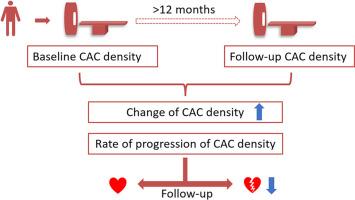Progression of coronary artery calcium density and major adverse cardiovascular events
IF 4.9
2区 医学
Q1 CARDIAC & CARDIOVASCULAR SYSTEMS
引用次数: 0
Abstract
Background and aims
We aimed to investigate the relationship between coronary artery calcium (CAC) density progression and major adverse cardiovascular events (MACE), and the prognostic value of CAC density progression.
Methods
Patients with serial CAC scans were enrolled in this study. CAC density was directly measured in calcified lesions. Change and rate of progression of CAC density were calculated. Cox proportional hazard regression was utilized to estimate hazard ratios (HRs) for time to MACE regarding CAC density. The incremental prognostic value and the reclassification ability of CAC density progression were evaluated using the C-index and continuous net reclassification index (NRI).
Results
304 patients (57.86 ± 9.47 years, 69.4 % male) were included. There were 47 MACE over a follow–up period of 76.00 (56.00–95.00) months. After adjustment for risk factors and CAC volume, the change of CAC density was inversely associated with MACE (per 10HU: HR: 0.956, 95 % confidence interval: 0.920–0.992, p = 0.018). Adding the change of CAC density to risk factors and baseline CAC density improved the C-index (0.694 vs. 0.678, p = 0.026). Adding the change of CAC density improved reclassification of MACE compared with risk factors and baseline CAC density [NRI = 0.432 (0.016–0.789)].
Conclusions
CAC density progression is inversely associated with MACE. The addition of the change of CAC density improves prognostic value compared to baseline risk factors and CAC density and optimizes risk reclassification.

冠状动脉钙密度的进展与主要不良心血管事件。
背景与目的我们旨在研究冠状动脉钙化(CAC)密度进展与主要不良心血管事件(MACE)之间的关系,以及CAC密度进展的预后价值:本研究招募了接受连续 CAC 扫描的患者。方法:本研究招募了接受连续 CAC 扫描的患者,直接测量钙化病灶的 CAC 密度。计算CAC密度的变化和进展率。利用 Cox 比例危险回归估算出 CAC 密度与 MACE 发生时间的危险比 (HRs)。使用C指数和连续净再分类指数(NRI)评估了CAC密度进展的增量预后价值和再分类能力:共纳入 304 名患者(57.86 ± 9.47 岁,69.4% 为男性)。在76.00(56.00-95.00)个月的随访期间,共有47例MACE。在对风险因素和 CAC 容量进行调整后,CAC 密度的变化与 MACE 呈反比(每 10HU HR:0.956,95 % 置信区间:0.920-0.992,p = 0.018)。在风险因素和基线 CAC 密度的基础上增加 CAC 密度的变化,可改善 C 指数(0.694 vs. 0.678,p = 0.026)。与危险因素和基线CAC密度相比,增加CAC密度变化可改善MACE的再分类[NRI = 0.432 (0.016-0.789)] :结论:CAC密度的增加与MACE成反比。结论:CAC密度的变化与MACE成反比。与基线风险因素和CAC密度相比,CAC密度的变化提高了预后价值,并优化了风险再分类。
本文章由计算机程序翻译,如有差异,请以英文原文为准。
求助全文
约1分钟内获得全文
求助全文
来源期刊

Atherosclerosis
医学-外周血管病
CiteScore
9.80
自引率
3.80%
发文量
1269
审稿时长
36 days
期刊介绍:
Atherosclerosis has an open access mirror journal Atherosclerosis: X, sharing the same aims and scope, editorial team, submission system and rigorous peer review.
Atherosclerosis brings together, from all sources, papers concerned with investigation on atherosclerosis, its risk factors and clinical manifestations. Atherosclerosis covers basic and translational, clinical and population research approaches to arterial and vascular biology and disease, as well as their risk factors including: disturbances of lipid and lipoprotein metabolism, diabetes and hypertension, thrombosis, and inflammation. The Editors are interested in original or review papers dealing with the pathogenesis, environmental, genetic and epigenetic basis, diagnosis or treatment of atherosclerosis and related diseases as well as their risk factors.
 求助内容:
求助内容: 应助结果提醒方式:
应助结果提醒方式:


